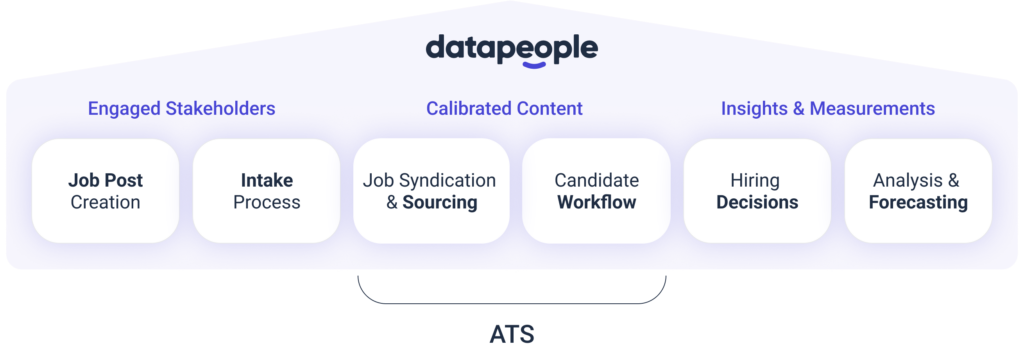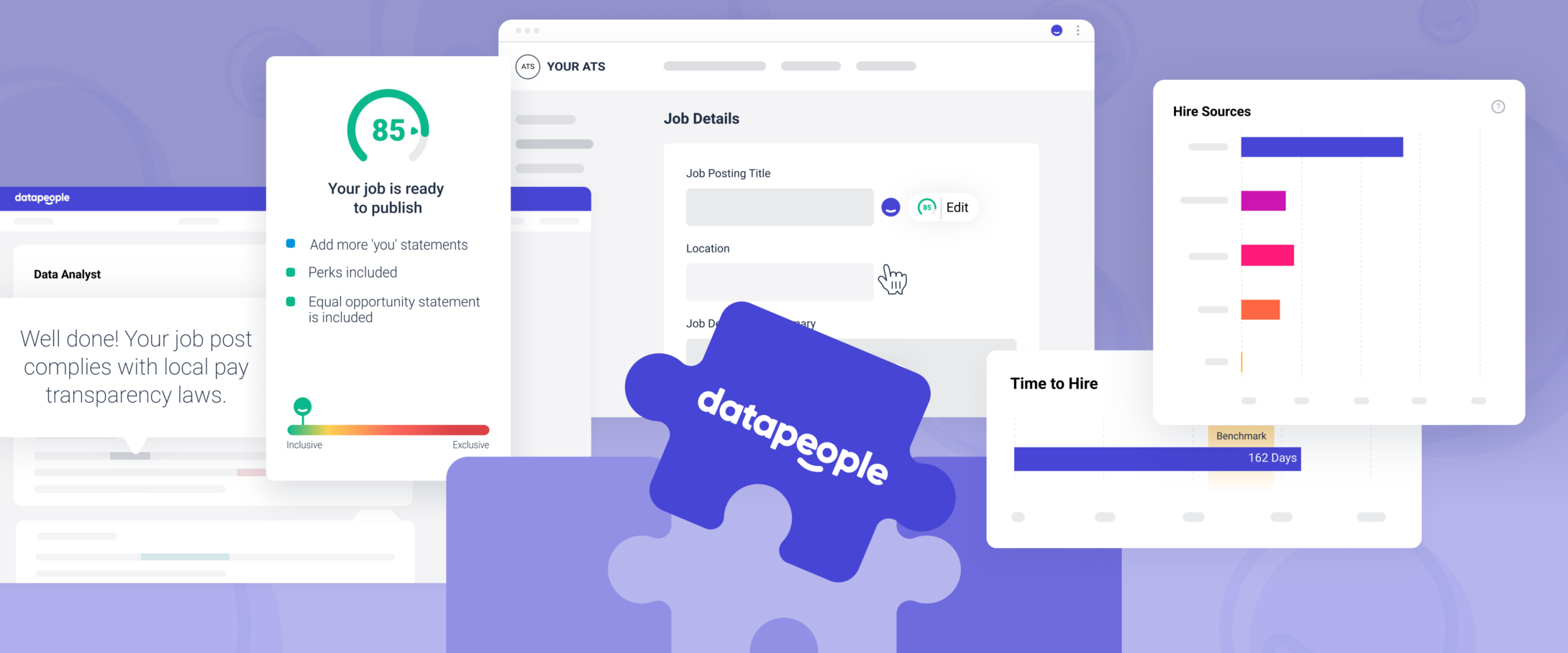If you’re like most recruiting teams, you may rely solely on the hiring analytics in your ATS to inform your recruiting strategy. These analytics can (with some manual work on your part) provide valuable insights into job syndication, sourcing, and the candidate funnel.
However, these insights only cover the parts of the hiring process that occur in the ATS and not everything end to end. Consider the impact that the job post creation and intake processes have on hiring outcomes and how these steps are completely excluded from your ATS. Similarly, the end of the hiring process – where you measure and analyze how your recruitment efforts have performed and forecast future outcomes – lives outside of your ATS.
These critical yet siloed steps in the hiring process are crucial to building a well-rounded recruiting strategy and achieving your hiring goals, but it’s impossible to tell if these processes are helping or hurting your hiring efforts without intelligence and control of the entire process living in one place.

Put simply, today’s talent acquisition teams lack end-to-end intelligence and control throughout the hiring process. The ATS provides critical information during the middle of your hiring efforts, but Datapeople fills in the gaps from start to finish.
The problem: Your ATS’s limited hiring analytics window
Only about two-thirds of requisitions result in a hire. That’s not a typo – 31% of all recruiting efforts end without a hire, which we discovered by analyzing over 125,000 jobs and their hiring outcomes from about 100 companies. And some of the biggest trouble areas occur in parts of the process not tracked in your ATS. Let’s dive into this.
More often than not, the job post is the first and only thing a candidate sees before deciding whether or not to apply to your role, so it’s critical your job postings are attractive, inclusive, and calibrated to the market. Yet, the steps that lead to the job posting – identifying a need, opening a requisition, assembling the hiring team, establishing responsibilities and requirements, and ensuring your employer brand is communicated effectively – aren’t systematically informed by data, and they often don’t adhere to a consistent process. They’re certainly not all tracked in your ATS.
Fast-forward to the final steps of the hiring process where you analyze, refine, forecast and plan based on historical hiring data. Your ATS captures the raw data that jumpstarts this process; however, extracting actionable insights that inform your strategy is quite a manual process. Without standardizing your ATS hiring stages – which usually differ based on each role’s seniority level, department, and the like – and bucketing individual candidate sourcing channels into consistent categories, unlocking critical process and source-related hiring metrics from your ATS is near impossible.
This lack of standardization leads to difficulties like determining how many applicants you need to make a hire. Or accurately benchmarking hiring efforts internally as well as externally. Or deciding where to allocate resources. And so on and so forth. In the end, the ATS is great at capturing data but not so great at making sense of it in order for you to make strategic recruiting decisions.
Effects of hiring analytics gaps:
Blind spots (or hard-to-interpret ATS data) in your hiring analytics can lead to unchecked bias, wrong assumptions, misinformed strategy, poor resource planning, and missed hiring goals. You can’t tell what’s working and not working, other than anecdotally, and the lack of intelligence turns into a lack of control. Below are just a few ways that TA teams are negatively affected by a lack of data throughout the entirety of the hiring process:
- Lack of qualified and underrepresented candidates: Without the intake and job writing process being market-calibrated, rooted in fairness, and optimized for successful hiring outcomes, your candidate pipelines are at risk
- Increased time to fill: TA teams that don’t have clarity on what’s working at the start and end of their hiring processes may inadvertently allocate resources to the wrong places, resulting in a longer time to fill
- High drop-off rates: When hiring processes aren’t backed by data they are usually inefficient, inconsistent, and misaligned with candidate expectations, resulting in higher candidate drop-off rates
- DEI goals going unmet: Without clarity on how candidates are (or aren’t) entering and moving through your hiring funnel, you’re unable to identify unfair hiring practices that may be roadblocks for underrepresented candidates
…and more.
In the end, if you can’t measure the first part of the hiring process you can’t reliably plan, set realistic timelines, or allocate resources effectively. You can lose days, weeks, or even months to bad processes, and you may end up turning to an expensive search firm or sourcing platform in a last-minute bid to salvage the hiring effort. Meanwhile, if you can’t make sense of your historical hiring data, you’re bound to repeat the same mistakes quarter after quarter and year after year.
The solution: Datapeople Insights
Improving the first step in the recruiting process has major downstream benefits. By aligning the recruiter, hiring manager, and others from the start, you can avoid ineffective job posts and wasteful trips back to the drawing board. Also, learning from your mistakes helps you chisel away the rough edges in your hiring process for fewer no-hire reqs, drop-offs, rejected offers, and the like.
Datapeople Insights gives recruiting teams real-time answers about what’s working and what’s not working throughout your entire hiring process. Instead of blind spots, you get actionable intelligence on every stage, starting with your job posts all the way to post-mortems on offer acceptance rates. That intelligence, in turn, gives you control over the process as a whole – with no gaps.
Questions you can confidently answer with Datapeople Insights:
- How are we performing in hiring stages not covered within our ATS?
- How do our job titles, responsibilities, requirements, and more compare to the rest of the market?
- Are we compliant with employment laws in areas that require salary disclosure?
- Are our employer brand standards being adhered to across the organization?
- Do our job posts include inclusive language that welcomes candidates from all backgrounds?
- Where in our hiring process are candidates dropping out of our hiring process?
- Which sources have contributed the most (and least) applicants and hires?
- How does our time to hire compare to other companies?
- Are males and females moving through the hiring process at similar rates?
…and many more.
How those insights help you:
- Get actionable insights on the critical (yet often overlooked) hiring steps that fall outside your ATS but have a huge impact on your hiring outcomes.
- Reduce time to fill by calibrating job titles, responsibilities, requirements, and more to real-time market data.
- Reduce cost per hire with compelling, calibrated job posts so you don’t have to prospect or pay for agencies or sourcing platforms as much.
- Maintain a consistent employer brand with uniform messaging and protect your employer brand with inclusive, compliant job posts.
- Engage all stakeholders, empower hiring managers, and lighten the workload of recruiters.
- Ease the burden of keeping up with ever-changing laws and regulations.
- Instantly make sense of your pipeline data so you can make strategic, data-driven hiring decisions
…and much more.
Datapeople Insights
With Datapeople Insights, we take the leg work out of recruiting data analysis so you can spend your time doing meaningful work, not manual work. Request a demo to get one step closer to more fair, efficient, and successful hiring outcomes.
